The Largest Shipmanagement Company in Europe
![]()
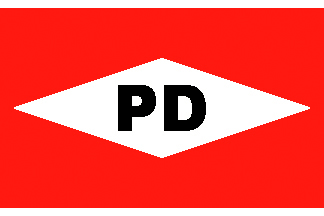 The Peter Döhle Group is the largest of six big container ship management companies domiciled in Hamburg, the others being Claus-Peter Offen, E. R. Schiffart (Blue Star Holdings), the reconstructed Rickmers Reederei and Zeaborn Group, NVA Norddeutsche, and NSB Niederelbe, and together account for 35% of the world container ship tonnage. Peter Döhle Schiffahrts K.G. emerged from the long established Hamburg shipping company of Robert Bornhofen Reederei in 1962 when Peter Döhle split away and set up his own business and continued as a sole proprietor under his own name. Peter Döhle had joined Robert Bornhofen Reederei in 1956, and from 1962 served as the principal partner of the Peter Döhle Group of companies until his death in 2001.
The Peter Döhle Group is the largest of six big container ship management companies domiciled in Hamburg, the others being Claus-Peter Offen, E. R. Schiffart (Blue Star Holdings), the reconstructed Rickmers Reederei and Zeaborn Group, NVA Norddeutsche, and NSB Niederelbe, and together account for 35% of the world container ship tonnage. Peter Döhle Schiffahrts K.G. emerged from the long established Hamburg shipping company of Robert Bornhofen Reederei in 1962 when Peter Döhle split away and set up his own business and continued as a sole proprietor under his own name. Peter Döhle had joined Robert Bornhofen Reederei in 1956, and from 1962 served as the principal partner of the Peter Döhle Group of companies until his death in 2001.
Jochen Döhle, son of Peter Döhle and Margot Döhle, was born in Hamburg on 28th October 1955, and he graduated in 1974 and trained as a shipping specialist with Ernst Russ in Hamburg and with insurance broker Jauch and Hubener of Munich and then worked for London and Paris insurance and freight forwarding brokers before joining the Peter Döhle Group as a managing partner on 1st May 1981. Christoph Döhle, his cousin born in 1965, later joined as a managing partner, and later still Jan Döhle, eldest son of Jochen Döhle and grandson of the founder, joined in November 2016 to manage the Peter Döhle Group along with Jochen Döhle and Christoph Döhle.
Robert Bornhofen Reederei (1911-1985)
Robert Leopold Bornhofen was born on 15th October 1880 in Koblenz and established a tugboat and lighter service on 1st May 1911. He became a steamship owner in 1923, and during the inter-war years he had a big fleet of coastal vessels engaged in the trade from North West Europe to the U.K. and the Baltic. The fleet had names such as Angeln, Kurland, Marta, Nordmark, Steinburg, Stormarn, Traunstein and Wagrien, names that were perpetuated in the motor coasters that traded in the Peter Döhle agency fleet after 1962, known as a Vertrauensmakler in Germany by shipowners, as an onshore agent to charter, operate and cost account the coasters for shipowners serving at sea.
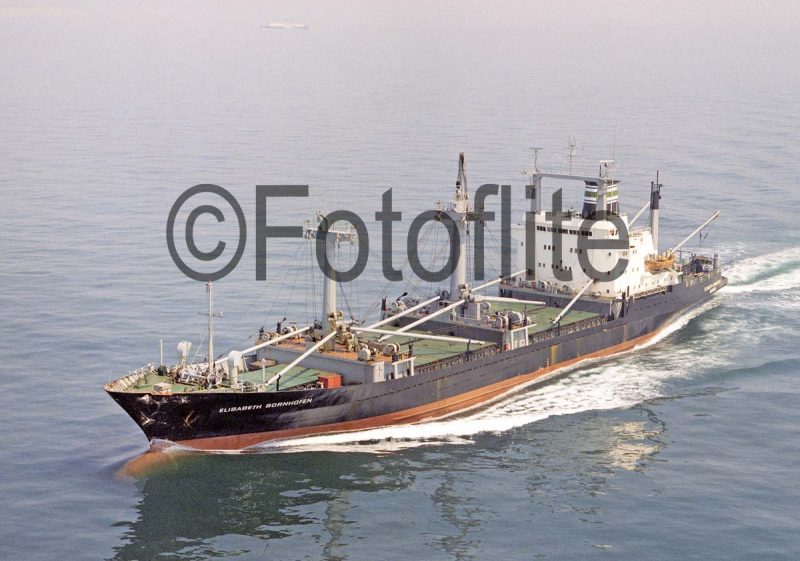
The entire Bornhofen fleet was lost during World War II, and the victorious Allies imposed stringent conditions on German shipowners, only allowing tugs and specialised coastal craft to operate until 1950. Hamburg had been totally destroyed by British and American bombers, with hardly a building left standing that had not been severely damaged. General George C. Marshall, Head of the U.S. State Department, announced in a speech at Harvard University on 5th June 1947 that America would give Germany large scale economic assistance. The Marshall plan was passed by Congress on 3rd April 1948 and was designed to help rebuild Germany and the rest of Europe.
German shipbuilding had got back into its stride in the 1950s, with 0.52 million gross tonnes in 1952, 0.81 million grt in 1953, 0.975 million grt in 1954, 0.93 million grt in 1955, 1.00 million grt in 1956, 0.81 million grt in 1957 and 1.06 million grt in 1958, the 1958 figure showing a remarkable percentage increase over 1957 and with 67.3% of the tonnage exported to overseas shipowning nations. MacAndrews & Co. Ltd. of London had eight fruit carriers built between 1954 and 1959 in German yards as Valdes, Valdivia, Velarde, Velazquez, Verdaguer, Villegas, Vives and Vargas of up to 2,650 dwt and sixteen knots service speed, while Blue Star Line had the fine cargo-liner Newcastle Star built in 1956 of 12,150 dwt with accommodation for six First Class passengers by the Bremer Vulkan yard at Bremen and powered by M.A.N. oil engines built at Augsburg.
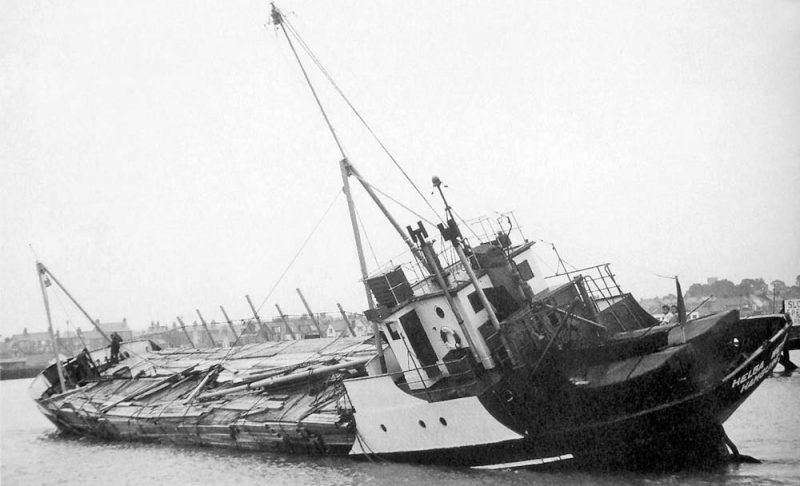
The Robert Bornhofen Reederei fleet was renewed in early post-war years from 1950 by eight deep sea general cargo ships of between 4,500 and 7,500 dwt from the yards of H. C. Stulcken and Son of Hamburg and the Elsflether Werft yard at Elsflether, all proudly wearing the black funnels with a white Maltese cross on a central red band between two narrow white bands. The shelterdeckers Robert Bornhofen and Luise Bornhofen of 7,400 dwt were delivered in 1956, and were followed by Karin Bornhofen of 7,600 dwt in 1958, all of this trio powered by twin geared M.A.N. diesels of 3,800 bhp to give service speeds of fourteen knots. Further new ships continued to be built for the Robert Bornhofen Reederei e.g. Luise Bornhofen of 9,200 dwt in 1967, Elisabeth Bornhofen of 9,304 dwt in 1971, Hans Bornhofen of 9,304 dwt in 1971, Max Bornhofen of 9,304 dwt in 1971, Peter Bornhofen of 12,590 dwt in 1971, Robert Bornhofen of 12,590 dwt in 1971, Wilhelm Bornhofen of 9,304 dwt in 1972 and Almut Bornhofen of 16,270 dwt in 1973, and the company managed to continue trading until 1985.
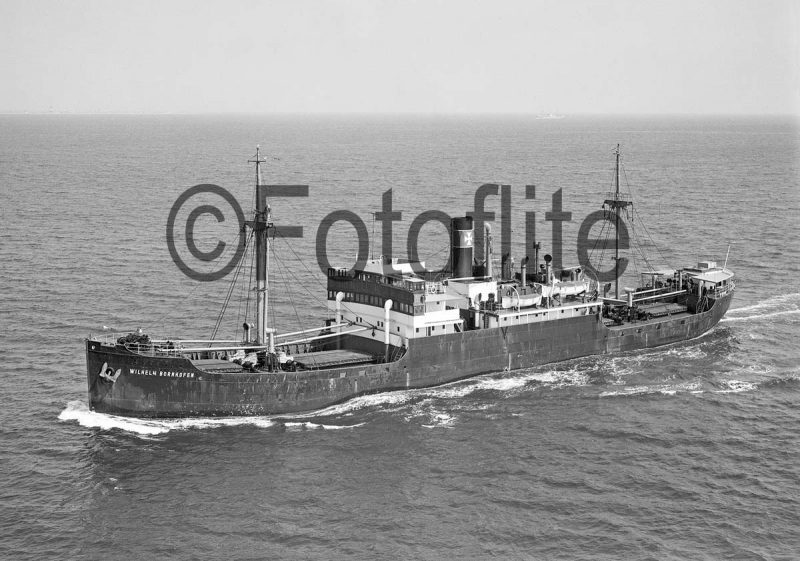
for H.C. Horn. In 1935 she became Boca Raton of Knoll Shipping and in 1936 she joined A/S Sobral as Rio Branco. She joined Robert Bornhofen in 1950. In 1959 she moved to Adel Abdul-Wahab as Amin before being broken up at La Spezia where she arrived on 21st October 1960. (FotoFlite)
Peter Döhle used part of the same offices at Mattentweite in Hamburg from 1962 as Robert Bornhofen Reederei. Initially, the Peter Döhle agency cared for between fifty and sixty small coasters, mostly new ‘paragraph’ coasters of 499 grt built in Germany and Holland that could be crewed by the owner plus a very small crew under their ‘paragraph’ restrictions. They carried coal, general cargo, bulk cargoes, and timber and forestry products around the Baltic and North Seas. However, there were also some ‘old-timers’ among the fleet that had been built more than fifty years ago.
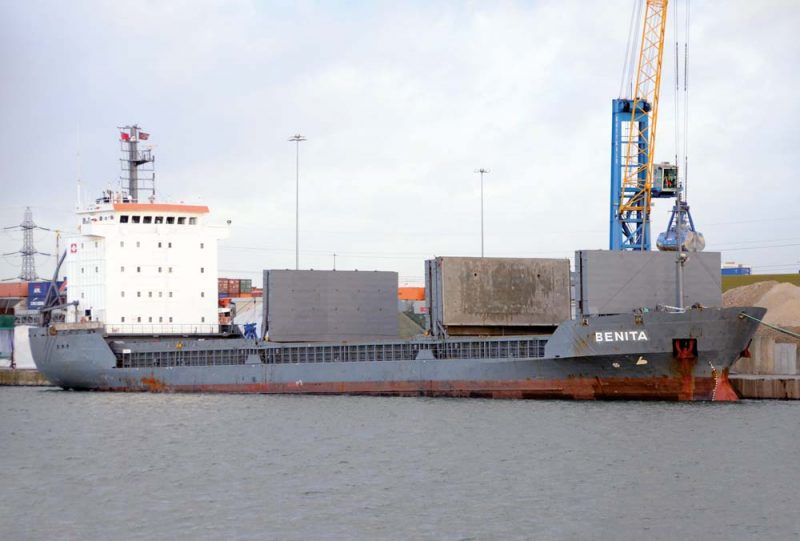
Osiris of 397 dwt had been built as a sailing ship at Marstal back in 1913, and was later fitted as an auxiliary powered coaster with a six cylinder Klockner Humboldt Deutz diesel by owner Hans Frugel.
The older Adele Hagenah of 430 dwt had been built in 1909 by J. Frerichs at Einswarden as Wilhelm, and was given a six cylinder diesel engine by Masch Kiel A.G. by owner Theodor Hagenah.
Hedwig Pannbacker of 450 dwt had been built in 1917 by Pattje and Zonen as Rebecca, and was fitted with a six cylinder diesel by Masch Kiel A.G. for her owner.
Lisa Oltmann of 227 dwt had been built as Maggie in 1910 by the Kaiserlicht Werft and was fitted with a four cylinder Klockner Humboldt Deutz diesel for owner Johannes Oltmann.

Andrea Luhman of 295 dwt had been built in 1913 by D. W. Kremer and Son at Elmshorn and was fitted with a six cylinder Klockner Humboldt Deutz diesel made in Koln.
Helga Wehr of 480 dwt had been built in 1919 by J.C. Tecklenborg at Bremerhaven and was fitted with the same type of diesel engine for her owner Oskar Wehr.
‘Paragraph’ Motor Coasters
‘Paragraph’ coasters were built in great numbers in post-war years, with the lower ‘paragraph’ limit of 499 grt and the upper ‘paragraph’ limit of 999 grt. A total of forty new motor coasters built between 1950 and 1962 made up the initial fleet of the Peter Döhle agency. These were mostly ‘paragraph’ coasters of 499 grt and between 810 and 850 dwt and crewed by a small crew on hull dimensions of length between 182.0 and 199.0 feet, moulded beam of 29.0 to 31.0 feet, and depth of 11.0 to 12.0 feet. They were fitted with six cylinder diesel engines manufactured by Masch. Kiel A.G. or Klockner Humboldt Deutz to give service speeds of nine or ten knots. These ‘paragraph’ coasters in later versions were built to lift up to 1,170 tonnes whilst still obeying their ‘paragraph’ conditions of trading. They were well equipped on the bridge with the latest direction finders, electric signalling devices, radar and radio telephone. Some examples were Capella, Claudia, Eggebek, Ernst Friesecke, Diana, Erik Seyd II, Ernst de Buhr, Flandria, Frauke, Freya, Frieda Buss, Friesland, Hans Oltmann, Gert Seyd, Hartwig Buss, Impala, Johanne, Jurgen Wehr, Martha Friesecke, Nautica, Regine, Reinbek, Sagitta, Stormarn, Steinburg, Ute and Wiking.

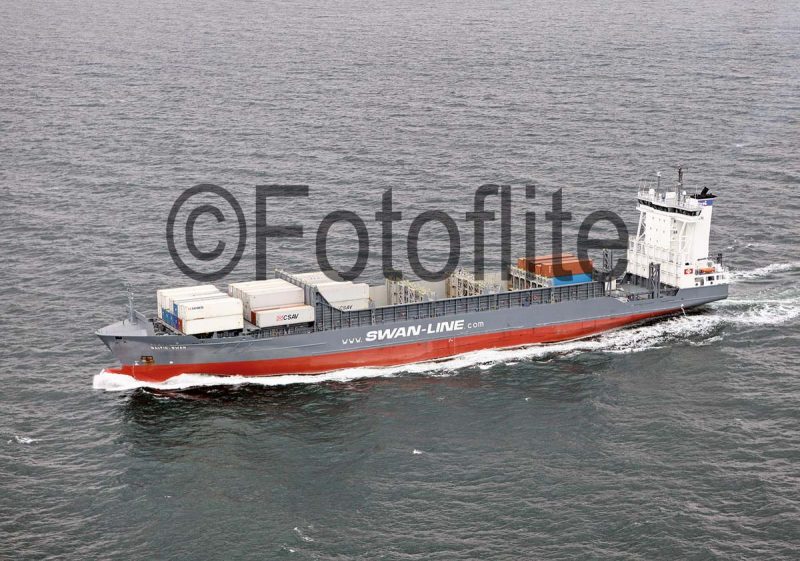
The 999 grt ‘paragraph’ coasters were built from the mid 1960s onwards for owners under the care of the Peter Döhle agency with names such as Anglia, Christa Kerstin, Corvus, Joachim, Julia, Katharina, Leana, Litania, Marianna, Marstal, Nad King, Nad Monarch, Passat, Sagitta, Roswitha, Salzburg and Widukind. These examples were mostly ungeared, while other similar ships traded on charter to the Scol Group as Scol Hunter, Scol Progress, Scol Unit and Scol Spirit with two deck cranes for unloading containers. They could carry 1,500 tonnes of cargo with later container carrying versions built to lift between 2,000 and 2,500 tonnes of cargo whilst still obeying their ‘paragraph’ conditions of trading. Examples of the 999 grt ‘paragraph’ coaster were also built for the Heinrich family of Paul, Hans and Hinrich Heinrich as Frauke, Comar II, Regine and Mosta, and all with very useful deck container carrying capacity.
The First Döhle Container Ships
Impala of 999 grt and 63 TEU capacity, a Type 58 by J. J. Sietas, was completed in 1968 as the first new owned container ship and was chartered out to European Unit Routes, a P. & O. affiliated company engaged on a liner service between the U.K. and Holland. Impala had dimensions of length 242.4 feet, moulded beam of 35.6 feet and depth of 13.0 feet with a draft of 10.6 feet, and an 8-cylinder Klockner Humboldt Deutz diesel of 1,320 bhp gave a service speed of 12.75 knots while carrying 1,276 tonnes of bulk cargo. Actuaria of the Type 58 by J. J. Sietas lasted 43 years in service, before arriving at a scrapyard in Denmark in 2011.
Twenty new small feeder container ships were completed by 1973 to carry between 63 TEU and 205 TEU, including Salzburg of 999 grt (183 TEU) in 1972 by the Korneuburg yard on the left bank of the Danube in Austria, and sisters Joachim and Sagitta of 999 grt (205 TEU) in 1972/73 by Korneuburg and J. J. Sietas. Joachim of 999 grt and 2,746 dwt had hull dimensions of length 296.7 feet, moulded beam of 48.5 feet, and depth of 15.3 feet with a draft of 13.0 feet. She was built in 1972 by Korneuburg with a more powerful Mannheim Motoren diesel of 3,000 bhp to give a service speed of fifteen knots. Joachim was sold in 1975 and chartered out to Prince Line in 1977 for two years as Stuart Prince.
Larger general cargo vessels were completed for the ownership of Peter Döhle or for shipowners under the care of the Peter Döhle agency. Among these were Rugia of 3,619 dwt completed in 1967 for Peter Döhle by the Orenstein Koppel Masch yard at Lubeck on dimensions of length 300.3 feet, moulded beam of 45.7 feet, and depth of 21.4 feet. She had twin six cylinder diesels of 1,330 bhp geared to a single screw shaft to give a service speed of thirteen knots. She was later fitted by Döhle with a specially designed travelling gantry crane on deck, and could load or discharge around forty or fifty containers onto her deck, transhipped from larger container ships coming into Scandinavia and Northern Europe. The gantry crane was removed when she was sold on for further service in 1976,
Carolina of 5,300 dwt could carry 133 TEU of containers on deck and was completed by the J. J. Sietas yard in 1970 with an Atlas MaK diesel engine to give a service speed of 15.5 knots. Katjana completed in 1971 by the Orenstein yard could carry 270 TEU of containers, and was of 6,800 dwt as an open shelterdecker or 8,350 dwt as a closed shelterdecker and had three holds and three hatches served by four cranes of sixteen tonnes capacity, and with a good service speed of 16.5 knots from a twelve cylinder four stroke Atlas MaK diesel of 6,000 bhp.
Cellular container ships began to appear in the Peter Döhle fleet in the late 1970s and early 1980s, such as Katjana of 737 TEU capacity built in 1982 and on charter to Contship Lines as Contship Asia between 1982/83. An ‘A’ class of Actuaria (806 TEU), Amaranta (605 TEU), America (1,208 TEU), Arabella (806 TEU), Apollonia (914 TEU) and Altonia of 1,128 TEU capacity were mostly built by J. J. Sietas at Hamburg and Flender Werft at Lubeck, with the latter pair chartered out as Zim Brisbane for Zim Lines of Israel, and Ville du Sahara for CMA of France.
The semi-container ships Carolina and Charlotta of 517 TEU capacity were built by the Howaldtswerke yard in 1978 with three holds and three hatches. They were chartered to United States Lines and were carrying empty containers when the charterer was bankrupted in 1985, and quickly offloaded their ‘empties’ to find other employment. Container ships joined Peter Döhle for the Döhle WAX (West African Express) service e.g. Impala of 8,500 dwt was a ‘Neptun’ type completed for the Europe to West African service with three holds and three hatches and container handling derricks on three goalpost masts. Halina of 3,042 dwt completed in 1984 by J. J. Sietas was an example of a jointly owned ship, with Hans Otto Gadermann and Peter Döhle Gmbh as joint owners. She also carried 100 TEU of containers and had a service speed of twelve knots.
Peter Döhle chartered out many of his container ships to many of the major container lines e.g. CGM of France with CGM La Perouse built in 1985, Zim Lines with Zim Rio built in 1986, Nedlloyd with Nedlloyd Formosa built in 1987, Senator Lines with European Senator built in 1990, Gracechurch Line of London with Gracechurch Comet, Gracechurch Crown and Gracechurch Harp, Libra Lines of Brazil with Libra New York, MSC with MSC Argentina built in 1985, Norasia Line with Norasia Samantha and Norasia Susan built in 1985, Pacific International Lines (PIL) of Singapore with Sea Laurel built in 1983, Hapag with Brasil Express built in 1992, Contship Lines with Contship Asia, and Eagle Lines with Eagle Star and Eagle Sea. The size of Peter Döhle managed container ships had reached the 2,000 TEU capacity mark by 1990 when the new container ship Diana entered service as European Senator for Senator Lines from the Hyundai yard in South Korea.
An example of the large number of short term charters undertaken by Peter Döhle container ships is the quartet built in 1997/98 to the Warnow CV2500 design of 2,500 TEU capacity by German shipbuilders. They have had over thirty names in their twenty year careers:-
Liberta was christened at the Kvaerner Warnow Werft yard on 17th October 1997 but delivered as Montebello on her first charter. She then became Maersk Freeport in 1999, CSAV Chicago in 1999 and Austria in 2010.
Charlotta was christened as such but delivered as CGM Gauguin, becoming CMA CGM Gauguin in 2000, Lykes Traveller in 2001, Alianca Rotterdam in 2001, Columbus Chile in 2002, Alianca Hong Kong in 2004, CCNI Guayas in 2006, Hevetia in 2012 and MSC Nadriely in 2014.
Impala was christened as such but delivered as Brasil Star, becoming Cap Norte in 1998, Transroll Argentina in 1999, Sea Ocelot in 2000, Santos Express in 2002, Cap Norte in 2003, Cap Egmont in 2006, Belgica in 2008, Emirates Rafiki in 2010 and Elgi in 2017.
Heinrich S was christened as such at the Volkswerft Stralsund Gmbh yard but delivered as Zim Singapore I, becoming Heinrich S again in 2002, CCNI Cartagena in 2006, and Niledutch Cape Town in 2011.
The quartet are equipped with three container handling cranes of 45 tonnes capacity, and have hull lengths of 208.16 metres, moulded beam of 30.0 metres, depth of 16.45 metres, and loaded draft of 11.4 metres. A high service speed of 21 knots is provided by a seven cylinder two stroke B & W oil engine of 26,930 bhp.
The 3,000 TEU container ship size to the B178 design by the Stocznia Szczecin yard in Poland was reached by Döhle in 2001 with a series of ships launched as Albona, Azalea, Carmen, Celine, Chloe, Clarissa, Coletta, Cosima, Daphne, Demeter, Hebe, Julia, Katharina, Leto, and Zeus. A quartet of 5,527 TEU container ships with a beam of 40.1 metres completed in 2005/06 as Tamina, Tessa, Talassa and Tabea exceeded the Panama Canal size limitations for the first time. By 2006, Peter Döhle container ships had then moved up in size to 7,928 TEU capacity in the vessels Hammonia Bremen, Hammonia Hamburg, Hammonia Jork, and to 6,540 TEU capacity with Alda (renamed Pangal), Paine, Palena, Petrohue, Puelche, and Puelo. Amaranta was chartered to Yang Ming Line as YM Portland at 4,444 TEU capacity, and a class of a dozen container ships of 5,530 TEU capacity were launched as Adonia, Arida, Adda, Amazonia, Anguila, Arizona, Chacabuco, Choapa Cholguan, Limari, Longavi and Lontue before being taken on charter to CSAV and other major container lines. By 2014, Peter Döhle container ships had then moved up in size to 13,092 TEU capacity with a class of seven ships launched as Rio Lily, Rio Lucy, Rio Eliza, Rio Elena, Rio Lara, Rio Marie and Rio Ragna and built in 2014 for charter to the ill fated Hanjin Lines.
A sextet of ‘V’ class container ships of 1,719 TEU capacity was completed in 2004/07 as Victoria, Valdivia, Valentina, Vera D, Violetta and Viona on dimensions of length 179.0 metres, moulded beam of 28.0 feet, and depth of 21.0 feet. Victoria sailed from Latakia in Syria in March 2011 on a charter from CMA CGM to load containers at Mersin (Turkey) in the Gulf of Iskenderun for Alexandria. However, she was seized by Israeli commandos two hundred miles off the Israeli coast, as the Israeli authorities believed that she had loaded weapons in Latakia that could be used by the Palestinian militant groups in the Gaza Strip.
Bulk Carriers
Peter Döhle began managing bulk carriers in the late 1980s, with examples such as the sisters Arosia and Ariella of 32,454 dwt built in Japan by Kanda Zoshensho in 1983 with five holds and five hatches on an overall length of 183.0 metres, and they were chartered out to d’Amico of Italy as Cielo di Vancouver and Cielo di Istria. Adriana of 38,913 dwt was built in 1983 and purchased in 1994 for worldwide trading and arrived in the Tyne in January 2000 to load a cargo of scrap metal. Three former Dutch owned bulkers Moordrecht, Meerdrecht, and Mijdrecht of 44,600 dwt, built by Gotaverken at Gothenburg in 1978/79, were purchased in 1996 and renamed Siam Harmony, Siam Prosperity and Siam Sincerity respectively and traded worldwide on charter to Bangkok owners.

The Peter Döhle offices in Hamburg in 1998 were at Palmaille 33 and still retained an atmosphere of a family run business, however the move later to the Elbehaussee office of a holding company had a different set-up and procedures and a much larger number of employees. Peter Döhle Gmbh did not rely on German KG finance to purchase their own bulkers and container ships, but did hold a stake in the KG finance house HCI Capital, and later in September 2003 teamed up with HCI and GE Transportation Finance to establish a ship management company called Hammonia Reederei.
There are several other Peter Döhle subsidiaries including:-
Döhle Assekuranzkontor, insurance broker.
DPM (Döhle Personal Management), which offers services for external customers for the manning of vessels.
Döhle Schiffahrtslinien-Agentur, a line agency working for Swan Container Line, founded in 2003, which operates a regular scheduled service between Germany and St. Petersburg using feeder container ship Baltic Swan 11,662/04.
A Döhle ship management office was opened in the U.K. in 1989 and was based in Douglas, Isle of Man, with Midocean Maritime Ltd. formed in 1994 also in the Isle of Man and renamed as Döhle (IOM) Ltd. in 2001. The Isle of Man has good air links to Continental cities, as well as five ferry links in summer to Belfast, Heysham, Liverpool, Birkenhead and Dublin.
Teamworth Shipping based in the Isle of Man with 55% Döhle finance and 45% from a Chinese shipbuilder for joint venture newbuildings e.g. the bulker Teamworth No. 1 of 22,750 dwt completed in 2011, further joint shipbuilding ventures are planned.
Hanseatic Bunker Services Gmbh in Hamburg for bunkering and the trading and supply of fuels and lubricants for shipping.
The Panamax sized bulkers Atlanta of 73,300 dwt and Belgrano of 74,000 dwt joined the fleet in 1998/99, with the latter ship renamed Alabama in 2003, and three more ‘A’ class Panamax bulkers had joined by 2005 in Alicia, Atlantica and Attila. Southern Shipmanagement (Chile) Ltd. managed a trio of Handysize bulkers purchased by the Döhle Group in 2004/05 and renamed Glen Helen, Glen Maye and Glen Mooar. Hammonia Reederei Gmbh managed another bulker, Hispania of 43,222 dwt from 2003 and had been built as Pacific Governor in 1995. Splosna Plovba of Slovenia took over the management of Postojna (ex Glen Helen), Vipava (ex Glen Maye) and Slavik (ex Glen Mooar) from 2008. A quartet of mini bulkers of 6,900 dwt were also built in the mid 1990s with three holds and three hatches, three coming from a shipyard in Alexandria as Aida, Alexandria and Anglia, and the fourth as Aurelia of double hull construction from a shipyard in Istanbul, and which traded around the coasts from Northern Europe to the Mediterranean.
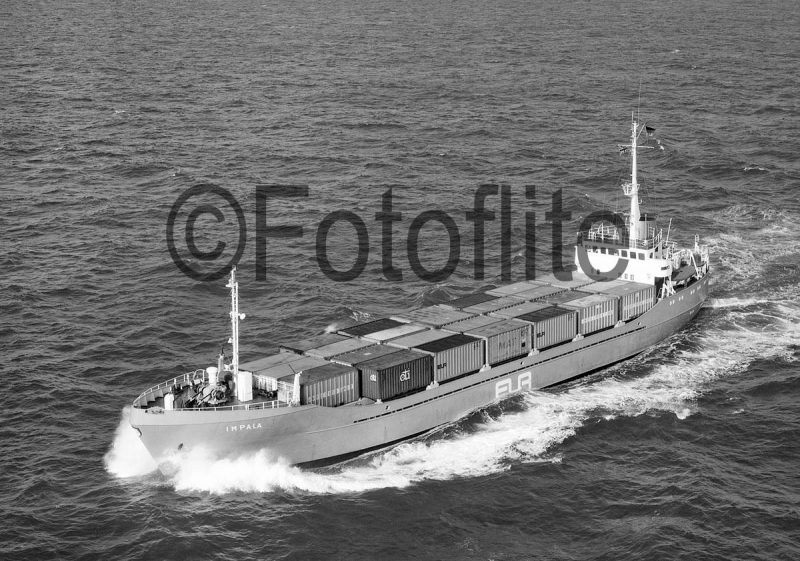
A pair of bulkers of 56,725 dwt was completed in 2010 as Hammonia Korsika and Hammonia Malta for management by Hammonia Reederei Gmbh. A quartet of bulkers of 93,250 dwt was completed in 2012 for Döhle Ship Management as TW Beijing, TW Hamburg, TW Jiangsu and TW Manila. Larger bulk carriers of up to 118,000 dwt later entered the Peter Döhle managed and owned fleet, as well as more Handysize, Panamax, and Kamsarmax sized vessels. The current fleet has the big sister gearless bulkers Edgar and Laura D of 118,800 dwt, the gearless John Wulff of 93,272 dwt, as well as the Panamax bulker Janna S of 75,021 dwt. There are also forty Handysize bulkers in the range from 37,800 dwt to 64,000 dwt and fitted with four pedestal cranes of between thirty and 36 tonnes capacity, and with service speeds of fourteen knots.
A co-operation between Peter Döhle Gmbh and AAL, a breakbulk, multi-purpose and heavy lift cargo specialist of Singapore, but founded in Holland in 1995 until it moved to Singapore in 2009, was announced in May 2015. This covers breakbulk cargo, heavy lift cargo, and project cargo, while both members remain independent of each other. A giant Capesize bulker of 200,000 dwt completed in 2015 for Oldendorff Shipping of Germany as Ludolf Oldendorff is managed technically by Peter Döhle for Oldendorff.
The Current Large Döhle Fleet
The large owned and managed Döhle fleet consists of around three hundred container ships of up 13,370 TEU capacity, forty bulk carriers of up to 118,935 dwt, and thirty multi-purpose ships of up to 13,450 dwt and 16,000 cubic metres hold capacity, some of which have a heavy lift capability of up to 700 tonnes when two cranes are used in tandem. The container ships are either owned, part owned, or managed and are chartered out to the major container lines such as:-
Maersk Line with Maersk Eureka, Maersk Enshi, Maersk Emerald, Maersk Ensenada, Maersk Edirne, Maersk Esmeraldas (all 9,000 TEU), and Maersk Kotka (7,908 TEU).
MOL of Japan with MOL Garland, MOL Gateway, MOL Generosity, MOL Genesis, MOL Guardian (all 5,695 TEU).
MSC of Italy with MSC Fabiola, MSC Faustina, MSC Fillipa, MSC Filomena (all 12,552 TEU), MSC Bilbao (8,204 TEU), MSC Karlskrona (7,908 TEU), MSC Kleven (7,908 TEU), MSC Paris (8,204 TEU), MSC Valencia (8,204 TEU), with the larger ‘F’ quartet engaged on the Europe to Far East service.
Hanjin of Korea, until bankrupted in 2016 when vessels were sold off, with Hanjin Africa, Hanjin America, Hanjin Asia, Hanjin Blue Ocean, Hanjin Europe, Hanjin Gold, Hanjin Green Earth, Hanjin Harmony, Hanjin Sooho (all 13,092 TEU).
Zim of Israel with Zim Chicago (8,242 TEU), Zim Los Angeles (8,242 TEU), Zim Djibouti (10,070 TEU).
CSAV Lines of Chile with several vessels chartered until taken over, including Malleco, Mataquito and Maullin (6,589 TEU)
CMA CGM of France with CMA CGM Pointe Marin (2,872 TEU), CMA CGM Wagner (5,770 TEU).
Emirates Lines of UAE with Emirates Dana, Emirates Sana, Emirates Wafa (all 6,539 TEU).
Hamburg Sud of Germany with Cap Palmas (2,524 TEU), Cap Melville (2,524 TEU) and Cap Mondego (2,742 TEU) which came off charter and were given the faraway island names of Easter Island, Christmas Island and Jeju Island. Currently chartered is Cap Corrientes (3,820 TEU).
JPO Lines ships owned by Oltmann Schiffahrts Gmbh and managed by Peter Döhle for employment on the WAX (West African Express) service with JPO Vela, JPO Virgo, JPO Volans, JPO Vulpecula (all 2,804 TEU), JPO Taurus, JPO Tucana (both 2,882 TEU), JPO Libra, JPO Pisces, JPO Capricornus and JPO Leo (all 2,400 TEU) and JPO Gemini, JPO Aquarius and JPO Aries (all 1,890 TEU). Four vessels also employed on the same service with the traditional Döhle names of Impala, Diana, Liberta and Sagitta of 1,300 TEU capacity.
Peter Döhle managed North Sea feeder container ships chartered out to Feederlink, Unifeeder, Imcl and other feeder lines e.g. Komet III, Planet V of 550 TEU, and a ‘C’ class of mini-bulkers of 7,600 dwt are employed on a regular service to the Mediterranean and the Black Sea from Northern Europe in Carla, Cassandra, Catalina, Cecilia, Celina, Centa, Chyra, Cimbria, Cindia, Clara, Cremona, Creola.
Independent Container Lines (ICL), a non Conference line with headquarters in Virginia (U.S.A.) with regular links between Wilmington (NC) and Chester (Pa) across the Atlantic to Antwerp and Liverpool, with Independent Accord (1,578 TEU), Independent Concept (1,578 TEU), Independent Pursuit (2,546 TEU), Independent Spirit (2,546 TEU), Independent Voyager (2,790 TEU).
Yang Ming of Korea with YM Portland (4,444 TEU).
TS Lines of Hong Kong with TS Hongkong (1,579 TEU).
Borchard Lines with Katherine Borchard (868 TEU).
American President Lines (APL), CCNI of Chile charters before taken over, and many other lines.
The forty bulk carriers in the present fleet are Handymax and Handysize bulkers in the range from 37,800 dwt to 64,000 dwt have names such as Achat, Alexandrit, Almandin, Alrayan, Amazonite, Ametrin, Aquamarin, Aragonit, Azurit, Calimero, Cas Amares, Cas Avanca, Conti Peridot, Hermann S, Hammonia, Korsika, Hammonia Malta, JPO Dorado, JPO Delphinus, Mia S, Novo Mesto, Novo Gorica, and a septet of ‘R’ class bulkers of 38,675 dwt completed in 2016 by the Jiangsu Hantong yard in China as Rabea, Rana, Ricarda, Riva, Rossana, Rosalia and Rubina, as well as Suse, Tamar, Trenta, Tatjana, TD Tokyo, TD Hamburg, Um Elhanaya, and Vil Atlantic. TD Tokyo and TD Hamburg were delivered to a joint venture named Tri-Do Shipping between Döhle and Mitsui of Japan.
The thirty multi-purpose vessels are versatile vessels able to lift project cargo up to 700 tonnes if two cranes are used in tandem, as well as taking up to 675 TEU of containers. They have hull lengths in the range from 100 metres up to 156.76 metres, and are named Andrina F, Antonia B, Celia, Diana, Emma, Ernst Hagedorn, Fortune, Foresight, Finesse, Fanfare, Fortitude, Favourisation, Greta, Impala, Karin, Liberta, Martha, Nadja, Nauma, Norrvik, Sagitta, Simon B, and Sonja. Nine more with heavy lift capacity are managed by Hammonia Reederei with ‘HR’ prefixes to their names of Constellation, Constitution, Endeavour, Resolution, Revolution, Recognition, Recommendation, Indication, and Intonation. The latter pair have twin heavy lift cranes of 350 tonnes capacity, the others have twin heavy lift cranes of 250 tonnes capacity, and all cranes can be used in tandem. Five multi-purpose and heavy lift vessels were purchased in 2011 from the bankrupt Beluga Lines and renamed Fanfare, Finesse, Foresight, Fortitude and Fortune.
The Peter Döhle Group does not own all of its ships, but acts as a chartering broker and manager for a large number of large, medium sized and small vessels, owning around one hundred ships with part ownership in another hundred ships. In 2017, Blue Net Chartering Gmbh was set up to operate from the Peter Döhle Group headquarters in Hamburg to serve all of its owned, part owned and managed container ships, as well as all of the container ships of the Greek Costamare fleet, as well as third party owned tonnage. This increased the total number of container ships in the fleet, which ranged from 700 TEU to 14,000 TEU capacity.
Subsidiary Shipping Companies
Ernst Russ Of Hamburg
Ernst Russ Gmbh was established by the founder of that name in 1893 and acted as an independent shipping company in the coal and timber trades of the North Sea and Baltic as well as worldwide tramping for 120 years until a joint venture was set up by the Peter Döhle Group on 1st August 2013 as Ernst Russ Shipbroker for all of the chartering of small feeder ships of both companies.
Menzell & Döhle Group
In 1999, Christoph Döhle, Chairman and Managing Partner of Peter Döhle Gmbh, and Jurgen Sengpiel, Chairman and Managing Partner of the Menzell Group, decided to pool their resources, knowledge and experience in liner shipping and established the Menzell & Dohle Group on 1st January 2000. The company offers bespoke solutions to freight forwarding, logistical, and shipping problems, acting as an agency for thirty shipping companies.
Postscript
The Peter Döhle Group has thirty worldwide offices including Hamburg, Isle of Man, Manila, Singapore, Gydnia, Odessa and in Latin America countries, with specialist container brokers fixing around one thousand charters per year. Two thousand staff are employed worldwide onshore, with 4,800 seafarers, making a total of 6,800 employees worldwide. The spectrum of the staff involvement in this huge fleet varies from chartering, financial, commercial and technical support, insurance services and crew placement to full agency services as well as bunkering and dry docking advice.
However, not all charters come to a successful conclusion, an example being the new Beaver Express Line, formed in August 1993 in Montreal after much shipper discontent with the Trans-Atlantic Agreement of 1992 of the powerful North Atlantic Conference. Beaver Express offered reductions of 10% on all freight tariffs, and had three container ships lined up for the start of the new service from Montreal. Beaver Dimitra of 673 TEU, built in 1993 as Hannes Oltmann, sailed from Montreal and was in the middle of her voyage when the largest shareholder in the company, a Montreal businessman that included real estate in his portfolio, withdrew his support and the company folded.
Two Peter Dohle Gmbh containerships of 1,012 TEU capacity had already been earmarked to complete the trio of ships needed for the new service. One of these had already loaded containers at Montreal but had not yet sailed, and Peter Döhle Gmbh had to engage a thirty party Montreal company to discharge the containers back to the quay.
A surprise managed ship in 2008 was the tiny coaster Silver River of 277 grt and 373 dwt built forty years earlier and registered under Mezeron Ltd. at Douglas in the Isle of Man. She was a reminder of the early days of Peter Döhle as a Vertrauens-makler agent for shipowners sailing as Masters at sea with a very small crew, and was dwarfed in the fleet by the four ‘F’ class giant container ships Fabiola, Fillipa, Faustina and Filomena of 12,552 TEU capacity. She was employed on a regular service between Ramsey, Isle of Man, and Belfast.
The Peter Döhle funnel colours are black with a black ‘PD’ on a white diamond on a white edged red central band, with hull colours varying from dark grey, light grey, black or blue with red boot topping, although many of this huge fleet wear their charterer’s colours on worldwide voyages.

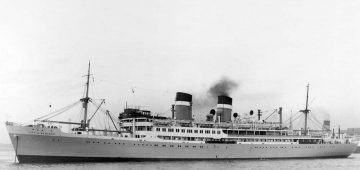
Comments
Sorry, comments are closed for this item